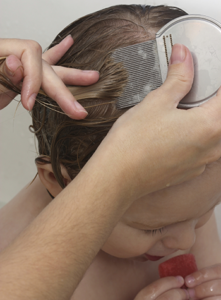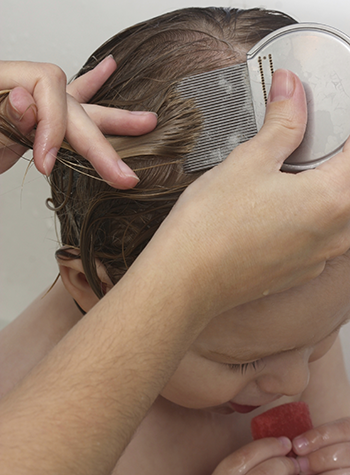 A year-round problem, the number of cases seems to peak when the kids go back to school in the fall and again in January, says Patricia Brown, M.D., a dermatologist at the Food and Drug Administration (FDA).
A year-round problem, the number of cases seems to peak when the kids go back to school in the fall and again in January, says Patricia Brown, M.D., a dermatologist at the Food and Drug Administration (FDA).
An estimated 6 to 12 million cases of head lice infestation occur each year in the United States in children 3 to 11 years of age, according to the Centers for Disease Control and Prevention. Head lice are most common among preschool children attending child care, elementary school children, and household members of children who have lice.
Contrary to myth, head lice are not caused by poor hygiene, Brown says. They are spread mainly by direct head-to-head contact with a person who already has head lice. You cannot get head lice from your pets; lice feed only on humans.
Lice don’t fly or jump; they move by crawling. But because children play so closely together and often in large groups, lice can easily travel from child to child, especially when they touch heads during playing or talking.
Blood-Sucking Bugs
Head lice are blood-sucking insects about the size of a sesame seed and tan to grayish-white in color. They attach themselves to the skin on the head and lay eggs (nits) in the hair.
According to Brown, you can check for head lice or nits by parting the hair in several spots. You can use a magnifying glass and a bright light to help spot them. Because head lice can move fast it may be easier to spot the nits. Nits can look like dandruff, but you can identify them by picking up a strand of hair close to the scalp and pulling your fingernail across the area where you suspect a nit. Dandruff will come off easily, but nits will stay firmly attached to the hair, Brown explains.
FDA-approved treatments for head lice include both over-the-counter (OTC) and prescription drugs, such as Nix and Rid, in the form of shampoos, creams and lotions. “Many head lice products are not for use in children under the age of 2, so read the label carefully before using a product to make sure it is safe to use on your child,” Brown says.
Although OTC drugs are available for treatment of head lice, Brown says your health care professional may prescribe drugs approved by the FDA, such as Ulesfia (approved in 2009), Natroba (approved in 2011) or Sklice (approved in 2012).
Steps for Safe Use
Follow these steps to use any head lice treatment safely and appropriately:
- After rinsing the product from the hair and scalp, use a fine-toothed comb or special “nit comb” to remove dead lice and nits.
- Apply the product only to the scalp and the hair attached to the scalp—not to other body hair.
- Before treating young children, talk with the child’s doctor or your pharmacist for recommended treatments based on a child’s age and weight.
- Use medication exactly as directed on the label and never more often than directed unless advised by your health care professional.
- Use treatments on children only under the direct supervision of an adult.
Heading Off Head Lice
- Teach children to avoid head-to-head contact during play and other activities at home, school, and elsewhere (sports activities, playgrounds, slumber parties, and camps).
- Teach children not to share clothing and supplies, such as hats, scarves, helmets, sports uniforms, towels, combs, brushes, bandanas, hair ties, and headphones.
- Disinfest combs and brushes used by a person with head lice by soaking them in hot water (at least 130°F) for 5–10 minutes.
- Do not lie on beds, couches, pillows, carpets, or stuffed animals that have recently been in contact with a person with head lice.
- Clean items that have been in contact with the head of a person with lice in the 48 hours before treatment. Machine wash and dry clothing, bed linens, and other items using hot water (130°F) and a high heat drying cycle. Clothing and items that are not washable can be dry-cleaned or sealed in a plastic bag and stored for two weeks.
- Vacuum the floor and furniture, particularly where the person with lice sat or lay. Head lice survive less than one or two days if they fall off the scalp and cannot feed.
- Do not use insecticide sprays or fogs; they are not necessary to control head lice and can be toxic if inhaled or absorbed through the skin.
- After finishing treatment with lice medication, check everyone in your family for lice after one week. If live lice are found, contact your health care professional.
[TLS]


Please. I implore all camps to make sure they have the kids checked. My daughters camp was infested with lice. Only notes were sent home. No one checked in camp. This lead to a huge problem when it came time for not check in schools.
Tea tree oil, which is natural and safe for any ages, will kill the lice. It is available in the health section of the coop, or at any store that carries natural oils. Sprinkle the oil on liberally, and comb/brush it through the hair. Leave it on for about 5 minutes, and the lice will die. You do have to comb them out with a nit comb, and pick out the nits. Repeat 5 days later (any remaining nits should have hatched by then, but will not be mature enough to lay more eggs). To be safe, repeat a third time 5 days later. The best nit comb is LiceLogic Terminator Nit Comb, which has grooved metal teeth (and is actually the comb in the picture above).
As a preventive measure, lice are repelled by the scent of rosemary oil. Good luck!